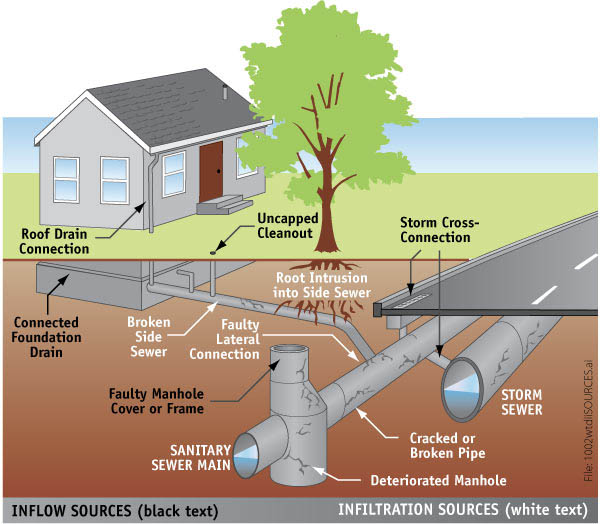Infiltration and Inflow Control Program
King County is working with our local sewer agencies to reduce and prevent infiltration and inflow (I/I) in our separated sewer system.
Our I/I Control Program helps protect the environment by maintaining pipe capacity for what’s it’s meant to convey—sewage—and preventing sewer overflows. It also decreases wastewater treatment costs by reducing the need for expensive capital projects to add sewer system capacity.
What is I/I?
I/I is a term we use for excess water that flows into sanitary sewer pipes from groundwater and stormwater. Infiltration refers to groundwater that infiltrates or leaks into pipes and inflow refers to storm or surface water that enters pipes from sources other than infiltration. In simple terms,
Inflow and infiltration = groundwater + stormwater
Infiltration seeps into sewer pipes through holes, cracks, joint failures, and faulty sewer pipe connections. Inflow flows into sewers via roof drain downspouts, foundation drains, storm drain cross-connections, and through holes in maintenance hole covers.
Why is I/I a problem?
In King County, we estimate that I/I makes up 75% of peak flows in our sewer system during the winter months. Extra water in our sewer system is a problem because it:
- Takes up capacity in our sewer pipes and ends up at one of our regional wastewater treatment plants where it must be treated like sewage, resulting in higher treatment costs.
- Requires new and larger wastewater facilities to convey and treat larger volumes of flow, resulting in higher capital expenditures.
- Contributes to sewer system overflows into local homes and the region’s waterways, negatively impacting public health and the environment.
I/I flows are a major reason why portions of our conveyance system are at or near capacity and require capital improvements. That’s why it’s important that we coordinate with our local sewer agencies to find and fix I/I in the separated sewer system when it’s cost effective to do so.

 Translate
Translate
